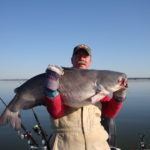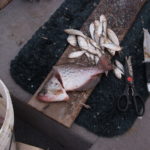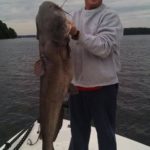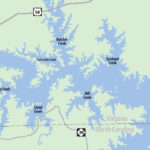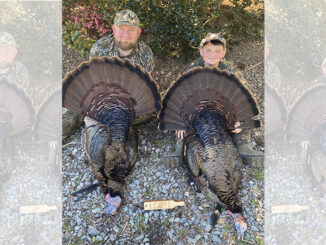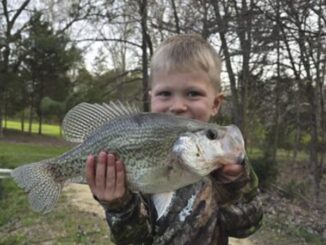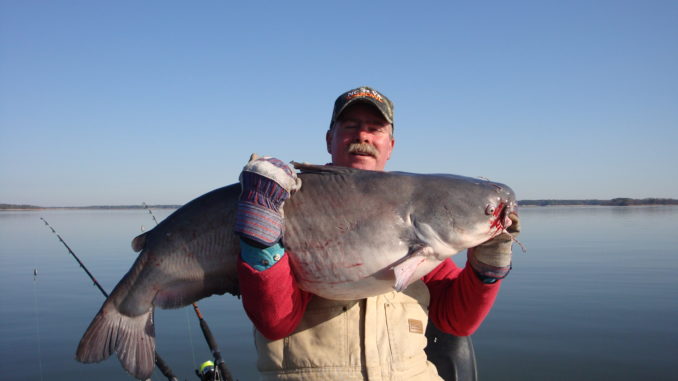
Drift or anchor for Kerr Lake’s big winter blue catfish.
Have you ever been swimming in a pond or lake and wondered whether a big fish might be swimming nearby? If you were swimming in Kerr Lake, aka Buggs Island, there’s a chance that fish might have been bigger than any you’ve ever seen.
On June 18, 2011, Nick Anderson, a 29-year-old high-school football coach from Kinston, caught a 143-pound blue catfish using a “family secret” bait. The 57-inch-long fish, which had a girth of almost 48 inches, was caught on part of the lake within Virginia borders, and it quickly became that state’s record and was later certified by the International Game Fish Association as the all-time, all-tackle world record for the species — breaking the previous record by more than 13 pounds.
While he has yet to land a blue catfish weighing more than 100 pounds, guide Chris Bullock has no doubts that one larger than Anderson’s is swimming in the 49,500-acre reservoir today. On his best day on Kerr, he landed blues that weighed 20, 30, 55 and 80 pounds. He’s caught several more 80-pound class fish and has had another hooked that he couldn’t do anything with. Anchored up when the fish bit, Bullock was unable to follow the fish before it peeled several hundred yards of line off his reel and eventually broke off. Now, he keeps two anchor buoys handy so he can follow a big fish and return to collect his anchors later.
And the winter is one season when Bullock expects to do battle with a number of blues, some of them big ones.
“You’ll typically average around eight fish a day in the winter, and there’s always a chance at a 50-pounder or better,” he said. “Being sight-feeders that eat live fish, blues have always liked cold water. It slows down and even kills some of the baitfish they eat — mainly shad, blueback herring and crappie. They get easy meals without using much energy.”
Bullock likes to head upstream, away from Kerr Dam, when he’s targeting blues. He said the surface water temperatures are a little warmer there during the winter.
“I like to go up in the rivers when it’s around 50 to 58 degrees, but not when it’s less than 48,” he said, explaining that as the water cools, he looks for bait in secondary creeks and goes to work, frequently targeting narrow spots in creeks that feed bigger tributaries, one of them being Butchers Creek, one of the major creeks on the northern side of the lake.
“I like to go in until you get to the first narrow spot and look for fish off the sides of the drops of those points,” Bullock said. “Look for the bait and set up. Anything coming through must pass by and will smell your bait.
“Turn off your sonar after you set up. Fish don’t like that pinging, and you don’t need it while you’re sitting still.”
Anchoring is easy when you get the knack for it. He anchors both ends of his boat to keep it from swinging in the current or wind, and he uses anchor buoys. He likes to drop the bow anchor first while slowly backing your boat, letting out 10 to 15 extra yards of line. Then, drop the stern anchor straight down and go back and pull the front anchor together so both anchors are out at an angle from the boat. A lone fisherman can perform this trick, but having a fishing partner makes it a lot easier.
Bullock recommends positioning the boat sideways off the edge of the drop so one side of the boat is facing deeper water and the other facing the flat above the ledge. That way, he can spread baits over various water depths. Bullock typically fishes a spread of 14 rods — seven out of each side of the boat.
“On a good drop, you can set up with more options, putting the baits on one side of the boat deep, the other side shallow, and some in between until you can pinpoint where the fish are,” Bullock said, explaining that big cats will “eat when they are resting if you get the right smell in front of them. “When you get a bite, a big fish will take off flying with the bait, while a small fish will peck at it.”
Bullock’s favorite bait for big blues is a gizzard shad. He’ll fish two of them on an 8/0 to 10/0 J hook, or he’ll cut a crappie in half and impale the head on the hook point, with some of the guts hanging out. He’ll also use white perch or yellow perch when available, saying they’re particularly good “big fish baits.” He will often fillet a crappie and use both sides.
Bullock tries to catch his baits during warmer weather and freeze them in large quantities for later use. He likes to store his baits in freezer baits, either squeezing out all of the air or freezing them in water, then thawing them when he’s ready to fish.
In Bullock’s opinion, blue catfish bite better in muddy water; he thinks they can smell the bait but not see the hooks or line. He prefers to fish on cloudy days, and he likes the first two or three hours every morning; he said that’s when blues are most active.
With the possibility of tangling with a huge fish fairly good, Bullock doesn’t skimp on the strength of his tackle. He matches stout, 7-foot catfish rods with Ambassadeur 6500 reels with line clickers. He spools his reels with 65-pound Power Pro braid. If he’s anchored, he’ll use a Carolina rig with a 30-pound leader of P-Line mono between the swivel and hook. He uses J hooks when anchored and circle hooks when drifting.
His drift rig is commonly called a “Santee rig.” It consists of a standard Carolina rig with a float midway between the hook and leader. Above the swivel, he threads on a fish-finder sleeve above a plastic bead, and to the sleeve, he clips a homemade weight consisting of a piece of coat-hanger wire crimped on each end with a pair of egg sinkers in between. This weight will easily slide over rocks and stumps without hanging up.
So if you’re ready to act like a catfish — get an easy meal without expending much energy — thaw out some bait, load up your gear and head to Kerr Lake. You could land the next world record, a fish bigger than you are.
DESTINATION INFORMATION
HOW TO GET THERE — Kerr Lake covers almost 50,000 acres along the North Carolina-Virginia border, about 45 minutes north of Raleigh. I-85 is the primary route to access to access the lake, with NC 39 and US 15 good bets to get fishermen close to the lake. The shoreline is dotted with public boat ramps, which can be found at http://www.zeemaps.com/pub?group=425066&x=-78.470319&y=36.586530&z=6&legend=1&simplesearch=1. Two of specific interest are at Island Creek Park off Ivy Hill Road near Clarksville, Va., and New Nutbush Park on Jack Wade Farm Road in Henderson. Island Creek Park charges a small fee, so carry dollar bills for the drop box or risk a ticket.
WHEN TO GO/WHERE TO GO — December through February are excellent months to catch big blue catfish on Kerr Lake. Prime areas to find fish are in the section from Island Creek to Eastland Creek. Smaller tributaries off Butchers and Panhandle creeks can be very productive. Try to set up in an area where the creek narrows down.
TACKLE/TECHNIQUES — Use heavy tackle: stout rods and big reels spooled with 60-pound braid and a Carolina rigs with 8/0 or 10/0 J hooks or circle hooks. Fish can be targeted either by drifting or anchoring up over a creek-channel drop and putting our rods at various depths.
GUIDES/FISHING INFO — Chris Bullock, Ker Lake Crappie and Cats Guide Service, 252-902-4039 or www.kerrcrappieandcas.com. See also Guides and Charters in Classifieds. Virginia and North Carolina have an agreement to recognize fishing license from either state across the entire fishery. Virginia manages the lake with a 20-fish daily creel limit on blue catfish, with only one fish longer than 32 inches allowed per day. North Carolina has no such regulations, so be careful about where you’re fishing with respect to the state line. A certificate from the NC Angler Recognition Program for a citation blue catfish can be issued with the minimum-size requirement being either 30 pounds or 41 inches.
ACCOMMODATIONS — Holiday Inn Express, Henderson, 252-438-6300; Vance County Tourism Development Authority, 252-438-2222 or www.kerrlake-nc.com. Camping is available at a number of sites around the lake; visit http://www.ncparks.gov/Visit/parks/kela/main.php.
MAPS — GMCO, 888-420-6277, www.gmcomaps.com.

